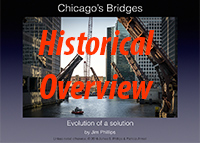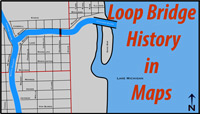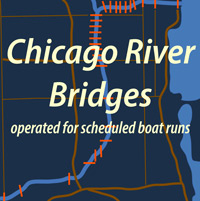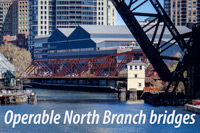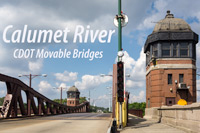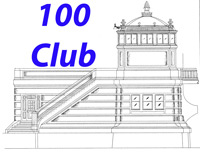N. Clark St - opened July 10, 1929

Elevation drawing adapted from original engineering drawings provided by CDOT Division of Engineering
GREAT PARADE TO OPEN SPAN, HAIL NEW ERA – Clark Bridge to Be Ready July 10
That's the headline from the Chicago Daily Tribune on June 30, 1929. The parade consisted of ten groups depicting the development of Clark Street from Indian trail to modern city thoroughfare. Organized by the North Clark Street merchants, the parade was a celebration of the new bridge and a show of appreciation to the Chicago Public Works Department for completing the bridge six months ahead of schedule.
Movable bridges have been at this Chicago River crossing since 1840 when a floating pontoon bridge was built. The swing bridge era began in 1856 and continued until the current bascule was built. The removal of the Clark Street swing bridge marked the end of the swing bridge era on the Main Stem of the Chicago River.
The last Clark Street swing bridge was removed sooner than expected when the sand sucker Sandmaster knocked the bridge off its turntable on April 30, 1929. Enough damage was done to the old bridge that fixing it made little sense with the new bascule under construction and nearing completion. The decision was made to abandon the old bridge and speed up the work on the new one. Remarkably, the first street cars crossed the new bridge only 48 days later on June 17.
With high tail-end curvaceous pony trusses and beaux arts styled bridgehouses, this Chicago-type trunnion bascule bridge has a striking and distinctive profile. The bridge plaque provides the organizations and individuals involved in the construction and design of the bridge.
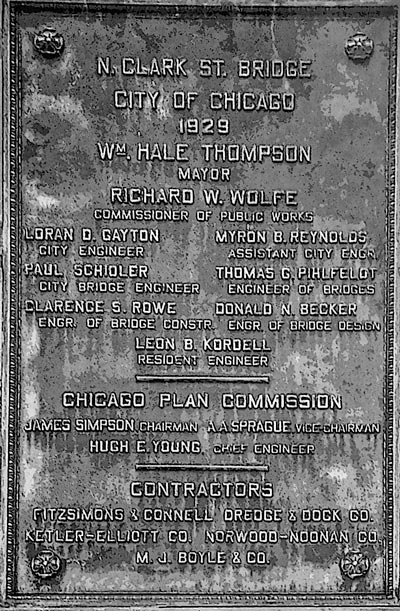
Bridge plaque
Pony trusses were not well liked by members of the Chicago plan commission. In a 1930 Chicago Daily Tribune article Eugene Taylor managing director of the Chicago plan commission put it simply, “They look like the devil...”
As often the case, site constraints here trumped aesthetic desires. Subsurface conditions dictated that trunnions be at shallower depths than those on bridges to the east. This meant more structural steel showing above the bridge deck here.
It could be argued today that this bridge provides visual relief from the sameness of the rail height trusses used on the bridges between here and Michigan Avenue. This was the last bridge built using pony trusses in the downtown area.

The North Clark St bridge - looking east on the Chicago River
The Sandmaster had a mishap under the new bridge during its first trip down the river since ramming the swing bridge. It collided with a barge and the wreckage prevented the bascule from being lowered into place. The accident caused a two hour delay but did not damage the bridge. After this encounter, the Sandmaster was the record holding bridge rammer – 45 collisions with 13 Chicago bridges in 3 years.
A number of things have happened in the eighty-five year life of this bridge. Probably the most unique event was the one time gathering of the Clark Street Bridge Percussion Orchestra on October 6, 2007. For an afternoon the bridge became a drum for six professional drummers and hundreds of spectators turned participants in concert. The event was organized by conceptual artist Hugh Musik for Chicago Artists Month. Eric Roth composed the music. It provided a different way to enjoy and appreciate one of Chicago's iconic bridges.
The Clark Street bridge is now operated about 40 times each year for seasonal sail boat runs to and from Lake Michigan. It is always amazing to see these Loop bridges operate.
Be sure to take advantage of the Chicago Riverwalk to walk under the Clark St bridge. There are a lot of reasons to like the Riverwalk, but for a bridge enthusiast the ability to watch a bridge rise above you is a special treat.

NW bridgehouse at the N Clark St bridge
Note: sources include: Chicago Daily Tribune 5/2/1929; 5/9/ 1929; 5/17/1929; 6/30/1929; 7/11/1929; 12/15/1929; 9/13/1930; 10/14/2007 (ProQuest Historical Newspapers Chicago Tribune (1849-2007); “Two Miles Eighteen Bridges – A walk along the Chicago River.”

